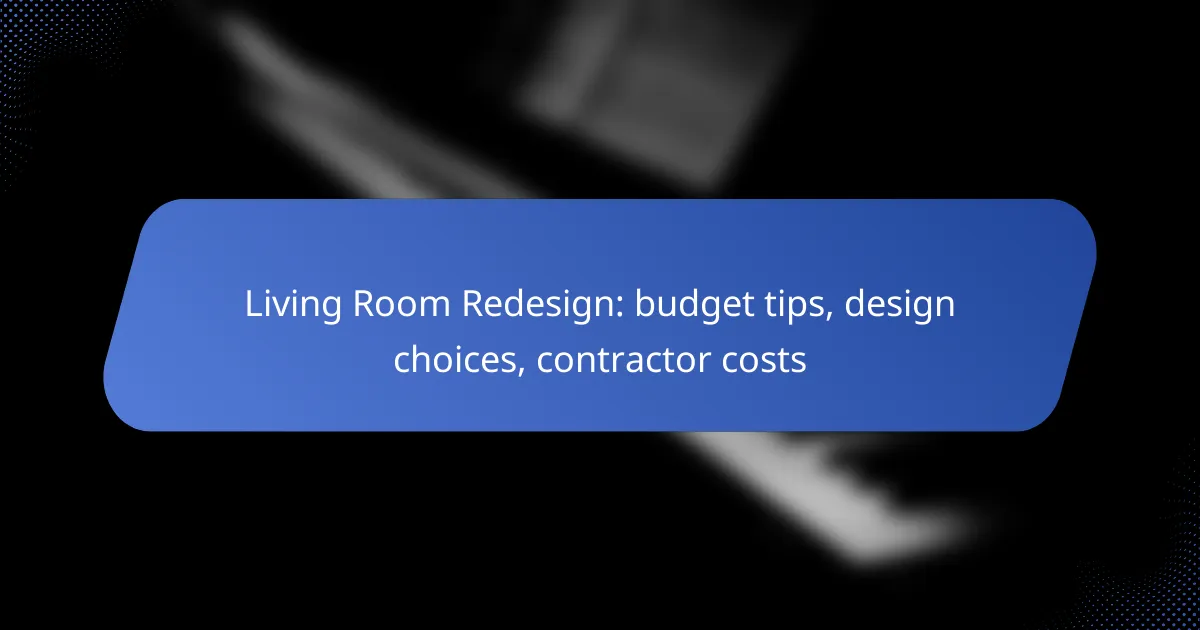Redesigning your living room on a budget can be both exciting and achievable with the right approach. By focusing on cost-effective materials, DIY projects, and thoughtful design choices, you can transform your space without breaking the bank. Additionally, being aware of contractor costs, which typically range from £20 to £50 per hour in the UK, will help you plan your budget effectively and ensure a successful redesign.

What are budget-friendly tips for living room redesign in the UK?
Redesigning your living room on a budget in the UK can be achieved through strategic planning and smart choices. Focus on cost-effective materials, DIY projects, and maximizing existing resources to create a fresh look without overspending.
Use affordable materials
Selecting affordable materials is crucial for a budget-friendly living room redesign. Consider options like laminate flooring instead of hardwood, or budget-friendly paint brands that offer a variety of colors without the high price tag.
Look for materials that mimic more expensive options, such as vinyl tiles that resemble stone or ceramic. These alternatives can significantly reduce costs while still providing a stylish appearance.
Prioritize DIY projects
Engaging in DIY projects can save money and add a personal touch to your living room. Simple tasks like painting walls, creating art, or even building shelves can be done with minimal investment.
Utilize online tutorials for guidance and inspiration. Remember to allocate time for these projects, as they can take longer than hiring a professional but will ultimately save you money.
Shop during sales
Timing your purchases can lead to significant savings. Look for seasonal sales, clearance events, or holiday discounts at local retailers and online stores.
Sign up for newsletters from your favorite home decor stores to receive notifications about upcoming sales and exclusive offers. This way, you can plan your purchases around these events to maximize your budget.
Repurpose existing furniture
Before buying new furniture, consider repurposing what you already own. A fresh coat of paint or new upholstery can breathe new life into old pieces, making them feel like new.
Mix and match different styles to create an eclectic look. For example, an old chair can be paired with a modern sofa to create a unique aesthetic without the cost of new furniture.
Set a clear budget
Establishing a clear budget is essential for a successful living room redesign. Determine how much you can realistically spend and allocate funds to different aspects of the project, such as materials, furniture, and decor.
Keep track of your expenses to avoid overspending. Consider using budgeting apps or spreadsheets to monitor your progress and make adjustments as needed, ensuring you stay within your financial limits.

What design choices can enhance a living room?
Design choices that enhance a living room focus on creating a harmonious and functional space. Key elements include color schemes, furniture selection, lighting, and layout, all of which contribute to the overall atmosphere and usability of the room.
Choose a cohesive color scheme
A cohesive color scheme can significantly impact the mood and aesthetic of your living room. Consider selecting a palette of three to five complementary colors that work well together, including a dominant color, a secondary color, and accent shades.
Neutral tones often serve as a good base, allowing you to add pops of color through accessories like cushions, artwork, or rugs. Aim for balance; too many contrasting colors can create visual chaos, while a well-chosen palette fosters a calming environment.
Incorporate multifunctional furniture
Multifunctional furniture maximizes space and enhances functionality in your living room. Look for pieces like sofas that convert into beds, coffee tables with storage, or ottomans that can double as seating.
This approach is particularly beneficial in smaller living rooms where space is limited. By choosing furniture that serves multiple purposes, you can maintain a clean, organized look while ensuring the room meets various needs.
Utilize effective lighting
Effective lighting is crucial for creating an inviting living room atmosphere. Combine ambient lighting, such as ceiling fixtures, with task lighting like floor lamps and accent lighting to highlight artwork or architectural features.
Consider using dimmable lights to adjust the brightness according to the time of day or activity. Layering different types of lighting not only enhances functionality but also adds depth and warmth to the space.
Focus on layout optimization
Optimizing your living room layout can improve flow and functionality. Start by determining the focal point of the room, such as a fireplace or television, and arrange seating to encourage conversation and comfort.
Leave enough space for movement, ideally allowing at least 24 inches between furniture pieces. Experiment with different arrangements to find the most inviting setup, ensuring that each area serves a purpose without feeling cramped.

How much do contractors charge for living room redesign in the UK?
Contractor fees for living room redesign in the UK typically range from £20 to £50 per hour, depending on various factors. Understanding these costs can help you budget effectively for your project.
Average hourly rates
The average hourly rates for contractors in the UK vary significantly based on their experience and the complexity of the work. Generally, you can expect to pay between £20 and £50 per hour. More specialized contractors, such as interior designers or skilled tradespeople, may charge upwards of £70 per hour.
Cost variations by region
Contractor fees can differ widely across the UK due to regional economic conditions. In London and the South East, rates are often higher, sometimes exceeding £60 per hour, while in Northern England or Wales, you might find rates closer to £20 to £30 per hour. Always consider local market conditions when budgeting for your redesign.
Factors affecting contractor fees
Additionally, the time of year can affect pricing, with peak seasons often leading to higher rates. It’s advisable to get multiple quotes and clarify what each includes to avoid unexpected costs.

What are the prerequisites for hiring a contractor?
Before hiring a contractor, ensure you have a clear understanding of your project requirements and budget. This preparation helps streamline the selection process and ensures you find a contractor who aligns with your vision and financial constraints.
Check credentials and reviews
Verifying a contractor’s credentials and reading reviews is crucial to ensure quality work. Look for licenses, insurance, and certifications relevant to your area, as these can vary by location. Additionally, check online platforms and ask for references to gauge past performance.
Pay attention to both positive and negative reviews. A contractor with a consistent record of satisfied clients is more likely to deliver a successful project. Consider reaching out to previous clients to discuss their experiences directly.
Obtain multiple quotes
Gathering multiple quotes from different contractors is essential for making an informed decision. This process allows you to compare pricing, services offered, and timelines. Aim for at least three quotes to get a well-rounded view of the market.
When reviewing quotes, ensure they include detailed breakdowns of costs, materials, and labor. Be cautious of significantly low bids, as they may indicate subpar quality or hidden costs. Instead, focus on the overall value provided by each contractor.

How can I compare design styles for my living room?
To compare design styles for your living room, start by identifying your preferences and the atmosphere you want to create. Consider how different aesthetics align with your lifestyle, budget, and existing decor.
Modern vs. traditional aesthetics
Modern aesthetics focus on clean lines, minimalism, and functionality, often using materials like glass and metal. In contrast, traditional styles emphasize warmth and comfort, featuring ornate details, rich woods, and classic furnishings.
When comparing these styles, think about how each will influence the space’s feel. Modern designs may require less maintenance and can create an airy atmosphere, while traditional styles often provide a cozy, inviting environment.
Scandinavian minimalism
Scandinavian minimalism is characterized by simplicity, functionality, and a connection to nature. This design style typically incorporates light colors, natural materials, and an uncluttered layout, promoting a serene and spacious feel.
To embrace Scandinavian minimalism, focus on essential furniture pieces and avoid overcrowding the space. Consider using light woods and soft textiles to create a warm yet minimalist ambiance.
Industrial design elements
Industrial design elements draw inspiration from warehouses and factories, featuring raw materials like exposed brick, metal, and wood. This style often includes open spaces and a mix of vintage and modern furnishings, creating an edgy, urban vibe.
When integrating industrial elements, balance the ruggedness with softer touches, such as plush seating or warm lighting. This contrast can help maintain comfort while showcasing the unique character of the industrial style.

What are the emerging trends in living room design?
Emerging trends in living room design focus on creating functional, comfortable spaces that reflect personal style while being mindful of sustainability. Key elements include the use of eco-friendly materials, multifunctional furniture, and a blend of indoor and outdoor living.
Sustainable materials
Sustainable materials are increasingly popular in living room design, offering both aesthetic appeal and environmental benefits. Options such as reclaimed wood, bamboo, and recycled metals not only reduce waste but also add unique character to the space.
When selecting sustainable materials, consider factors like durability and maintenance. For instance, bamboo is a fast-growing resource that is both strong and easy to care for, making it a great choice for flooring or furniture. Reclaimed wood can vary in cost, typically ranging from moderate to high, depending on the source and quality.
To ensure your choices are genuinely sustainable, look for certifications such as FSC (Forest Stewardship Council) or products that meet local environmental standards. Avoid materials with harmful chemicals or those that contribute to deforestation, ensuring your living room is both stylish and eco-conscious.










